Abstract
OBJECTIVE: To investigate the value of a giant negative T wave (> or = 1.0 mV) in precordial leads of 12-lead electrocardiograms in the acute phase of Q wave myocardial infarction as a predictor of myocardial salvage. METHODS: Coronary angiographic and electrocardiographic findings, left ventricular ejection fraction in the chronic stage, and levels of cardiac enzymes were compared in patients with myocardial infarction with (group GNT, n = 31) and without (group N, n = 20) a giant negative T wave. GNT patients were divided into two subgroups according to the presence (GNT:R[+], n = 10) or absence (GNT: R[-], n = 21) of R wave recovery with an amplitude > or = 0.1 mV in at least one lead that had shown Q waves. RESULTS: The maximum level of creatine kinase and the total creatine kinase were lower in group GNT compared with group N (P < 0.05). The left ventricular ejection fraction was higher in group GNT than in group N (P < 0.05). The maximum creatine kinase and total creatine kinase were lower in GNT:R(+) than in GNT:R(-) (P < 0.01). The left ventricular ejection fraction was higher in GNT:R(+) than in GNT:R(-) (P < 0.01). The frequency of R wave recovery was significantly higher when giant negative T waves appeared within 100 h of myocardial infarction or when the maximum potential was > or = 1.4 mV. The appearance of a giant negative T wave > or = 1.4 mV had a sensitivity of 90%, a specificity of 71.4%, a diagnostic accuracy of 77.4%, a positive predictive value of 60%, and a negative predictive value of 93.8% for prediction of R wave recovery. CONCLUSIONS: The appearance of a giant negative T wave, especially within 100 h of the onset of myocardial infarction, with a maximum potential of > or = 1.4 mV, may predict a reappearance of the R wave and a better left ventricular function in patients in the chronic stage of anterior myocardial infarction.
Full text
PDF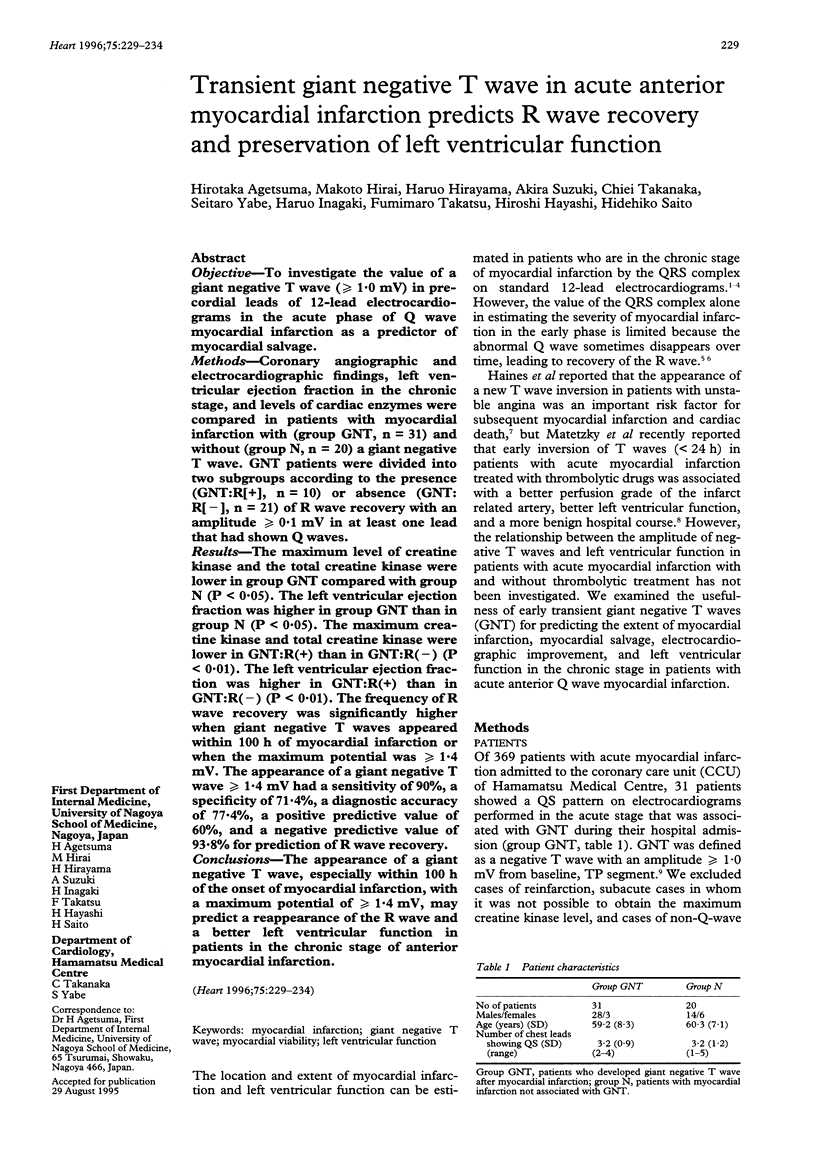
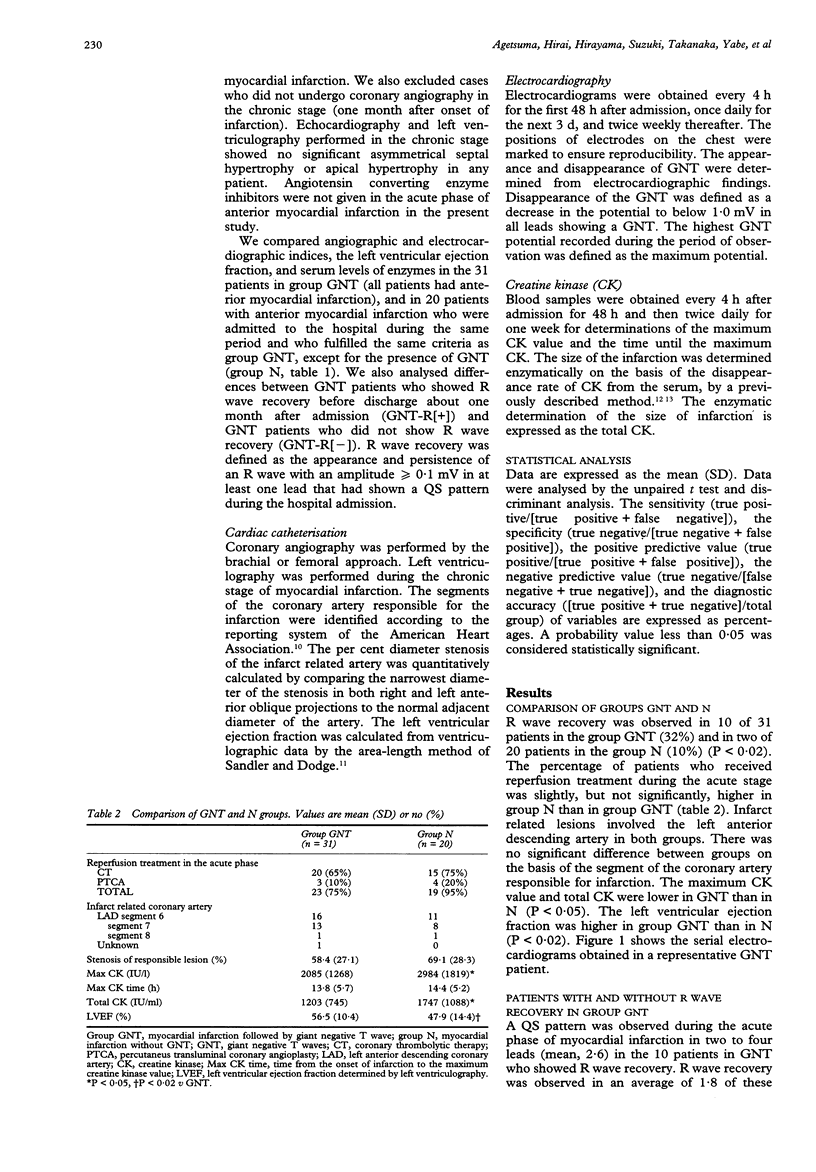
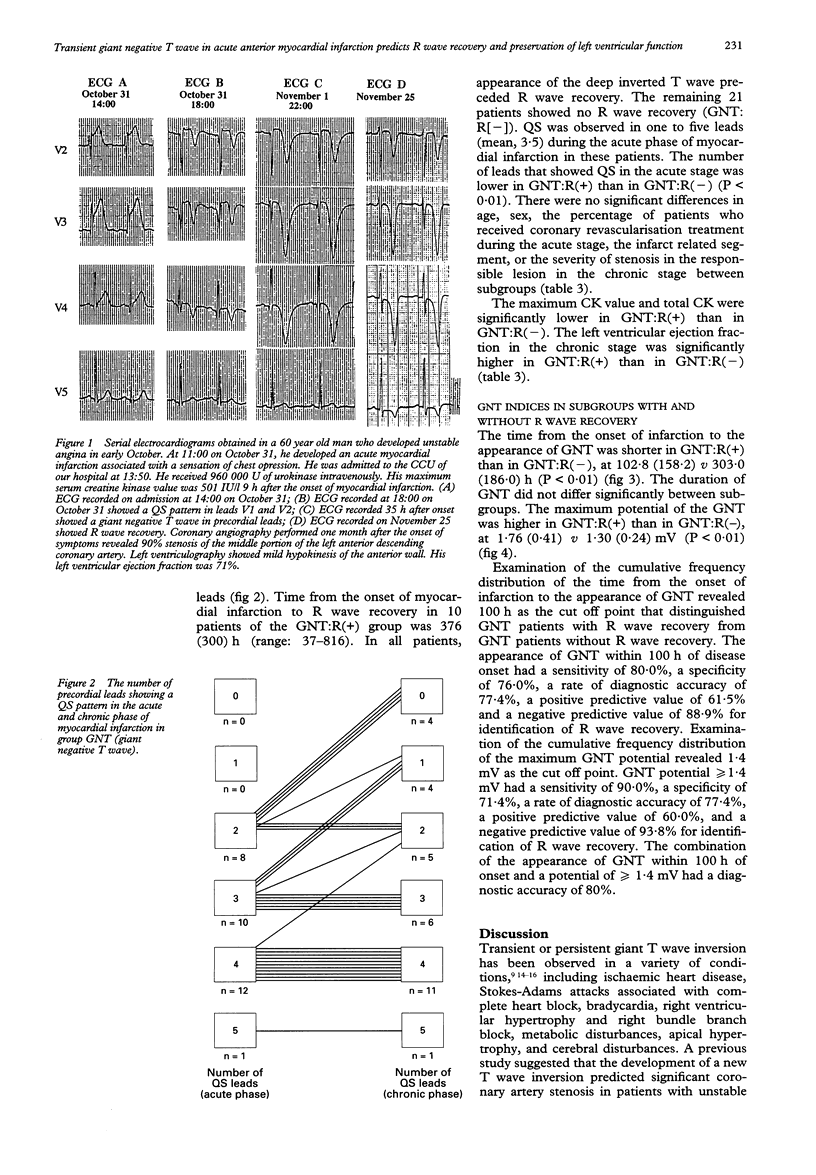
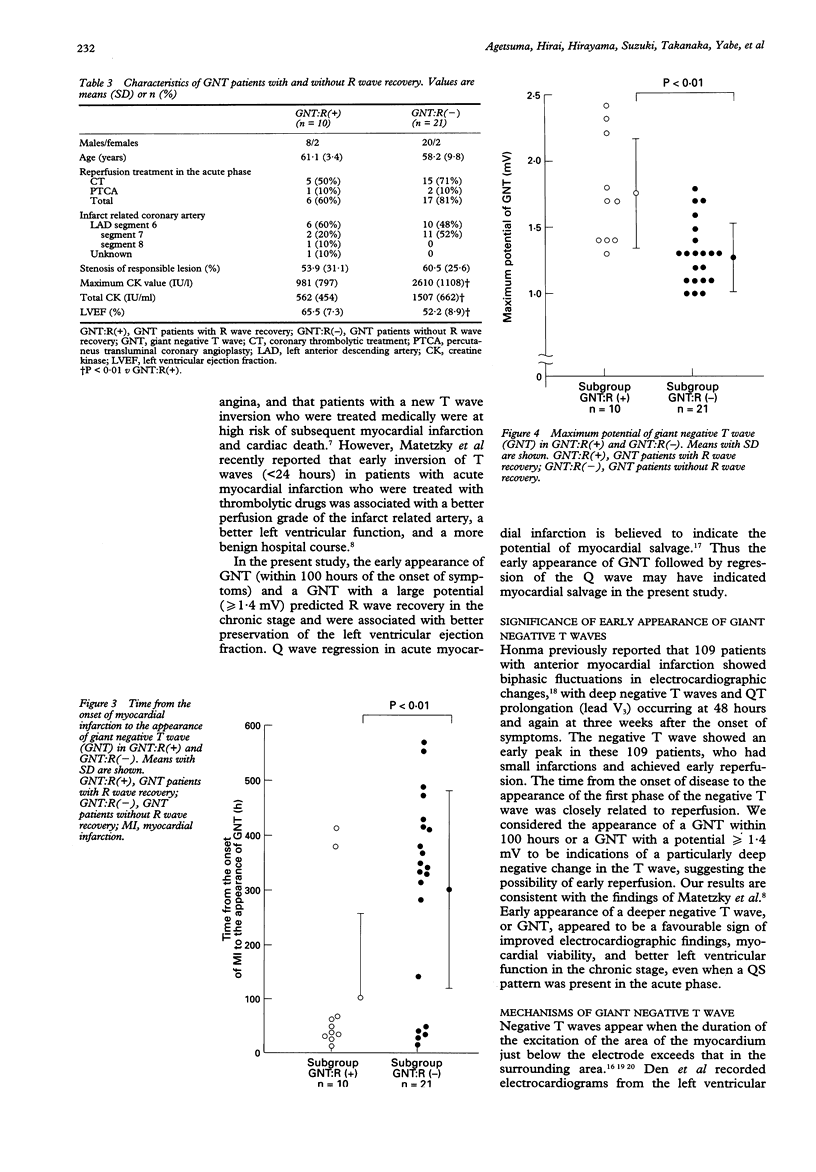
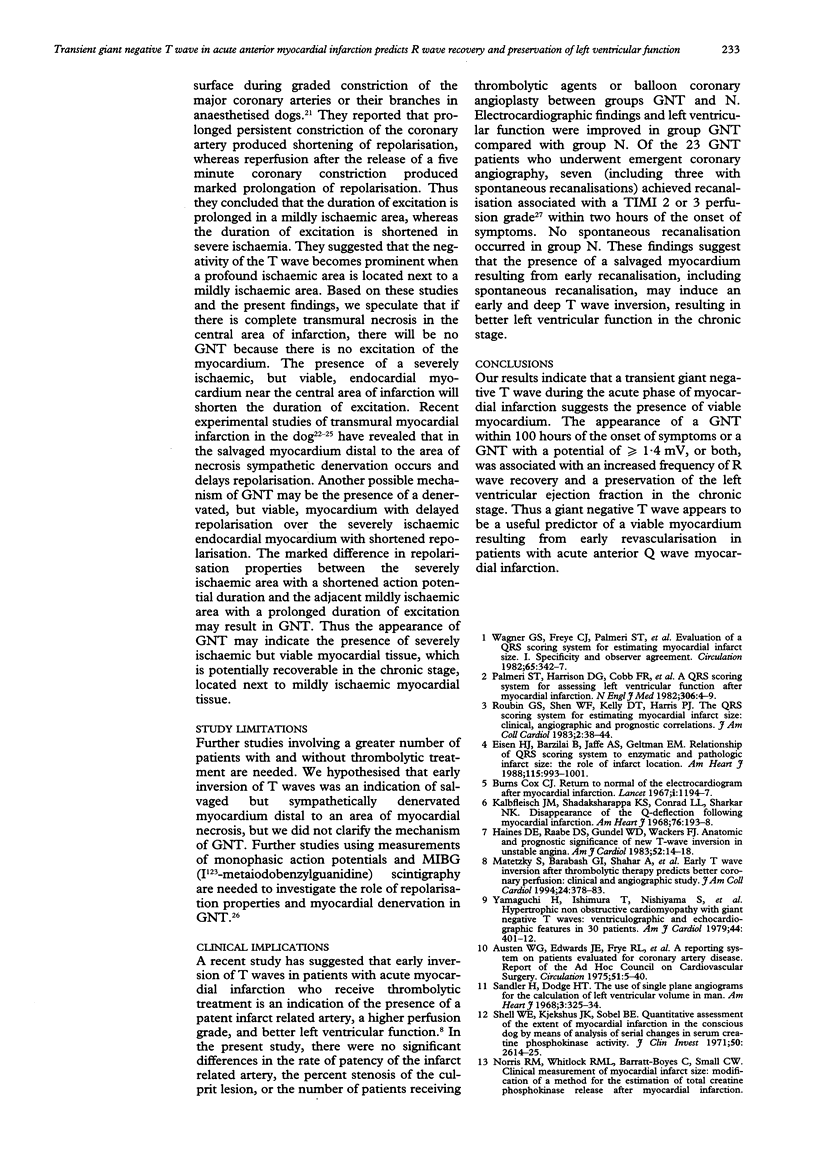
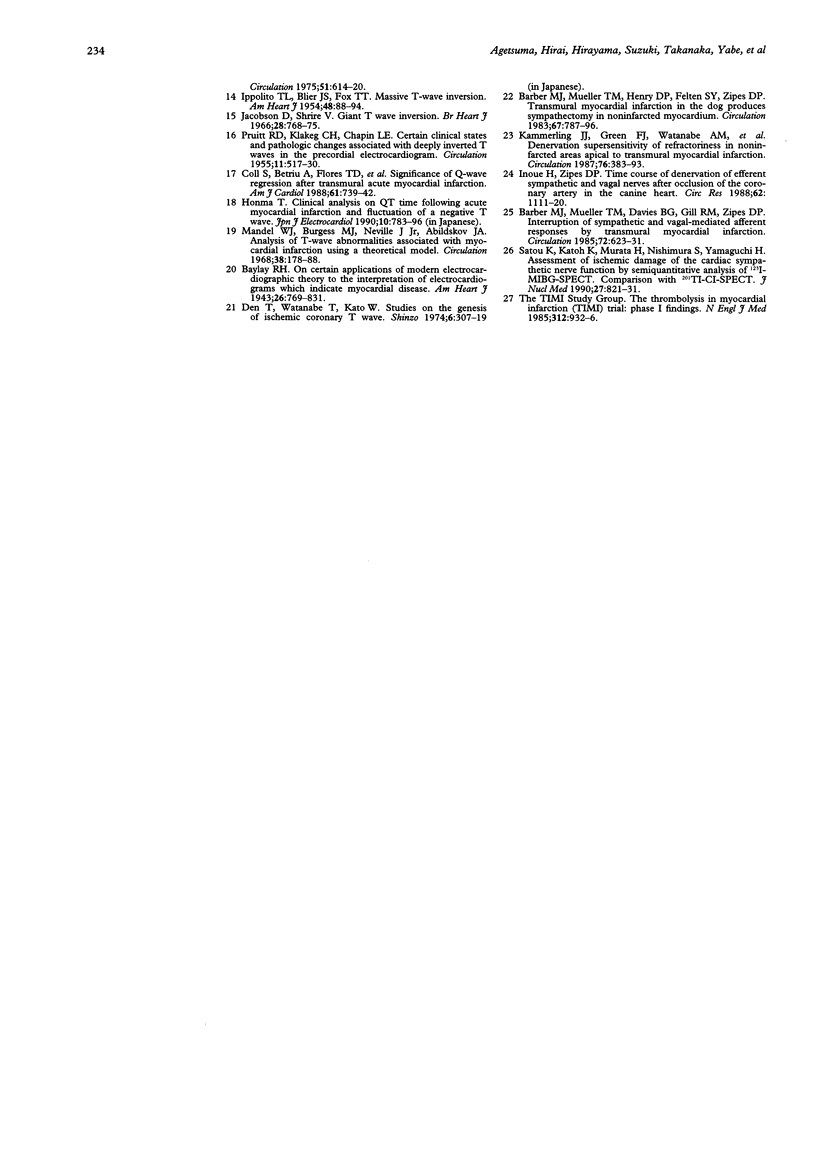
Selected References
These references are in PubMed. This may not be the complete list of references from this article.
- Austen W. G., Edwards J. E., Frye R. L., Gensini G. G., Gott V. L., Griffith L. S., McGoon D. C., Murphy M. L., Roe B. B. A reporting system on patients evaluated for coronary artery disease. Report of the Ad Hoc Committee for Grading of Coronary Artery Disease, Council on Cardiovascular Surgery, American Heart Association. Circulation. 1975 Apr;51(4 Suppl):5–40. doi: 10.1161/01.cir.51.4.5. [DOI] [PubMed] [Google Scholar]
- Barber M. J., Mueller T. M., Davies B. G., Gill R. M., Zipes D. P. Interruption of sympathetic and vagal-mediated afferent responses by transmural myocardial infarction. Circulation. 1985 Sep;72(3):623–631. doi: 10.1161/01.cir.72.3.623. [DOI] [PubMed] [Google Scholar]
- Barber M. J., Mueller T. M., Henry D. P., Felten S. Y., Zipes D. P. Transmural myocardial infarction in the dog produces sympathectomy in noninfarcted myocardium. Circulation. 1983 Apr;67(4):787–796. doi: 10.1161/01.cir.67.4.787. [DOI] [PubMed] [Google Scholar]
- Coll S., Betriu A., de Flores T., Roig E., Sanz G., Mont L., Magriñ J., Serra A., Navarro López F. Significance of Q-wave regression after transmural acute myocardial infarction. Am J Cardiol. 1988 Apr 1;61(10):739–742. doi: 10.1016/0002-9149(88)91058-2. [DOI] [PubMed] [Google Scholar]
- Eisen H. J., Barzilai B., Jaffe A. S., Geltman E. M. Relationship of QRS scoring system to enzymatic and pathologic infarct size: the role of infarct location. Am Heart J. 1988 May;115(5):993–1001. doi: 10.1016/0002-8703(88)90068-3. [DOI] [PubMed] [Google Scholar]
- Garrow J. S., Pike M. C. The long-term prognosis of severe infantile malnutrition. Lancet. 1967 Jan 7;1(7480):1–4. doi: 10.1016/s0140-6736(67)92417-8. [DOI] [PubMed] [Google Scholar]
- Haines D. E., Raabe D. S., Gundel W. D., Wackers F. J. Anatomic and prognostic significance of new T-wave inversion in unstable angina. Am J Cardiol. 1983 Jul;52(1):14–18. doi: 10.1016/0002-9149(83)90061-9. [DOI] [PubMed] [Google Scholar]
- IPPOLITO T. L., BLIER J. S., FOX T. T. Massive T-wave inversion. Am Heart J. 1954 Jul;48(1):88–94. doi: 10.1016/0002-8703(54)90276-8. [DOI] [PubMed] [Google Scholar]
- Inoue H., Zipes D. P. Time course of denervation of efferent sympathetic and vagal nerves after occlusion of the coronary artery in the canine heart. Circ Res. 1988 Jun;62(6):1111–1120. doi: 10.1161/01.res.62.6.1111. [DOI] [PubMed] [Google Scholar]
- Jacobson D., Schrire V. Giant T wave inversion. Br Heart J. 1966 Nov;28(6):768–775. doi: 10.1136/hrt.28.6.768. [DOI] [PMC free article] [PubMed] [Google Scholar]
- Kalbfleisch J. M., Shadaksharappa K. S., Conrad L. L., Sarkar N. K. Disappearance of the Q-deflection following myocardial infarction. Am Heart J. 1968 Aug;76(2):193–198. doi: 10.1016/0002-8703(68)90194-4. [DOI] [PubMed] [Google Scholar]
- Kammerling J. J., Green F. J., Watanabe A. M., Inoue H., Barber M. J., Henry D. P., Zipes D. P. Denervation supersensitivity of refractoriness in noninfarcted areas apical to transmural myocardial infarction. Circulation. 1987 Aug;76(2):383–393. doi: 10.1161/01.cir.76.2.383. [DOI] [PubMed] [Google Scholar]
- Mandel W. J., Burgess M. J., Neville J., Jr, Abildskov J. A. Analysis of T-wave abnormalities associated with myocardial infarction using a theoretic model. Circulation. 1968 Jul;38(1):178–188. doi: 10.1161/01.cir.38.1.178. [DOI] [PubMed] [Google Scholar]
- Matetzky S., Barabash G. I., Shahar A., Rabinowitz B., Rath S., Zahav Y. H., Agranat O., Kaplinsky E., Hod H. Early T wave inversion after thrombolytic therapy predicts better coronary perfusion: clinical and angiographic study. J Am Coll Cardiol. 1994 Aug;24(2):378–383. doi: 10.1016/0735-1097(94)90291-7. [DOI] [PubMed] [Google Scholar]
- PRUITT R. D., KLAKEG C. H., CHAPIN L. E. Certain clinical states and pathologic changes associated with deeply inverted T waves in the precordial electrocardiogram. Circulation. 1955 Apr;11(4):517–530. doi: 10.1161/01.cir.11.4.517. [DOI] [PubMed] [Google Scholar]
- Palmeri S. T., Harrison D. G., Cobb F. R., Morris K. G., Harrell F. E., Ideker R. E., Selvester R. H., Wagner G. S. A QRS scoring system for assessing left ventricular function after myocardial infarction. N Engl J Med. 1982 Jan 7;306(1):4–9. doi: 10.1056/NEJM198201073060102. [DOI] [PubMed] [Google Scholar]
- Roubin G. S., Shen W. F., Kelly D. T., Harris P. J. The QRS scoring system for estimating myocardial infarct size: clinical, angiographic and prognostic correlations. J Am Coll Cardiol. 1983 Jul;2(1):38–44. doi: 10.1016/s0735-1097(83)80374-x. [DOI] [PubMed] [Google Scholar]
- Sandler H., Dodge H. T. The use of single plane angiocardiograms for the calculation of left ventricular volume in man. Am Heart J. 1968 Mar;75(3):325–334. doi: 10.1016/0002-8703(68)90089-6. [DOI] [PubMed] [Google Scholar]
- Satoh K., Katoh K., Murata H., Nishimura S., Yamaguchi H. [Assessment of ischemic damage of the cardiac sympathetic nerve function by semiquantitative analysis of 123I-MIBG (metaiodobenzylguanidine)-SPECT--comparison with 201Tl-Cl-SPECT]. Kaku Igaku. 1990 Aug;27(8):821–831. [PubMed] [Google Scholar]
- Shell W. E., Kjekshus J. K., Sobel B. E. Quantitative assessment of the extent of myocardial infarction in the conscious dog by means of analysis of serial changes in serum creatine phosphokinase activity. J Clin Invest. 1971 Dec;50(12):2614–2625. doi: 10.1172/JCI106762. [DOI] [PMC free article] [PubMed] [Google Scholar]
- Wagner G. S., Freye C. J., Palmeri S. T., Roark S. F., Stack N. C., Ideker R. E., Harrell F. E., Jr, Selvester R. H. Evaluation of a QRS scoring system for estimating myocardial infarct size. I. Specificity and observer agreement. Circulation. 1982 Feb;65(2):342–347. doi: 10.1161/01.cir.65.2.342. [DOI] [PubMed] [Google Scholar]
- Yamaguchi H., Ishimura T., Nishiyama S., Nagasaki F., Nakanishi S., Takatsu F., Nishijo T., Umeda T., Machii K. Hypertrophic nonobstructive cardiomyopathy with giant negative T waves (apical hypertrophy): ventriculographic and echocardiographic features in 30 patients. Am J Cardiol. 1979 Sep;44(3):401–412. doi: 10.1016/0002-9149(79)90388-6. [DOI] [PubMed] [Google Scholar]


